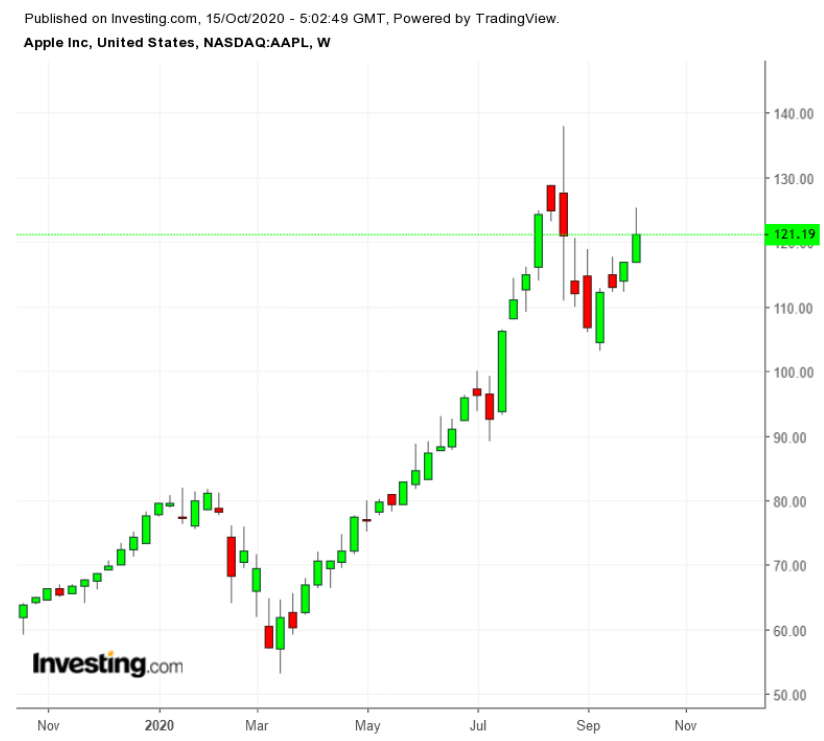S&P 500 climbs to trade near record levels
Apple (NASDAQ:AAPL) finally released its hotly anticipated new phone models on Tuesday, heralding what many analysts believe is another super growth cycle for the tech giant.
The California-based company unveiled four different iPhone models—the iPhone 12 mini, a 5.4-inch model starting at $699; a 6.1-inch device starting at $799, a 6.1-inch Pro model starting at $999; and a 6.7-inch pro model starting at $1,099.
All these iPhones run on a new wireless standard, known as 5G, that can transmit data as much as 10 times faster than the current 4G LTE technology. The iPhone 12 offered a new appearance, with a flatter-edged look reminiscent of the iPhone 4. Prices for the new phones were roughly in line with last year’s, though 12 Mini is the least expensive new version.
Apple Chief Executive Tim Cook, who hosted the virtual launch, confirmed that 5G support is coming to the full lineup of new iPhones. Verizon (NYSE:VZ) CEO Hans Vestberg, who also participated in the event, told the audience that the 5G service would reach 60 U.S. cities by the end of the year.
Verizon is also turning on its low-band 5G network in more than 200 cities to offer broad coverage, he said, adding:
“Until now, most people have taken a wait-and-see approach to 5G. They’ve been waiting for 5G to get real. Well today, with iPhone, the wait is over.”
Despite a craving for the new models among customers, Apple stock on Wednesday didn’t react wildly after the release, falling slightly during the session and closing at $121.19, up a 0.07% on the day.

The initial negative reaction, however, didn’t support many analysts' bullish view about the demand spur that 5G-enabled phones could create in the next few months.
New Pricing Makes iPhone More Attractive
Those expectations and Apple’s success in driving up services revenue helped it become the first U.S. public company to eclipse $2 trillion in market value earlier this year. Analysts surveyed by FactSet, on average, predict iPhone revenue will rise 15% to $160 billion in the fiscal year that began Oct. 1. That is about $6 billion shy of the record set in fiscal 2018, when the $1,000 iPhone X helped bolster sales even as shipments failed to reach a new high.
“The pricing dynamics are the killer app for the phone launch,” wrote Harsh Kumar of Piper Sandler & Co. in a research note cited by Bloomberg. “Pricing was lower than our expectation, which is important in the current global pandemic.”
Apple has been struggling to revive growth in iPhones as consumers hold onto their phones for longer. After the COVID-19-triggered recession that task became more challenging as millions lost their jobs and businesses closed down. Quarterly revenue from this segment peaked in the first quarter of Apple’s 2018 fiscal year. But Apple’s competitive pricing, the first major redesign in three years, and the attraction of faster speed could prompt users to upgrade as soon as the global economy gets out of a recession.
China Factor
Analysts are also bullish on sales in China, Apple’s second-largest market, where 5G networks are more advanced than in the U.S.
Dan Ives, an analyst at Wedbush Securities estimates that 350 million of 950 million iPhones worldwide are currently in the window of an upgrade opportunity.
In an interview with CNBC Ives, who has been predicting a super cycle for months, said:
“It really comes down to if Apple can exceed the 231 million peak units from 2015. If they can, then this goes into the Cupertino hall of fame as a super cycle. If they can’t, then the disappointment will be reflected in the stock.”
Even if Apple fails to generate enough momentum for its new models in the midst of a pandemic and a global recession, the company’s diversification strategy away from its hardware is working just fine and offers a good reason to remain excited.
With swelling revenues from its services, the company is also making more sales of its hardware accessories, like AirPods and Apple Watch, which have spurred impressive growth in its wearables business. During yesterday's launch, Apple also unveiled its first Beats headphones to feature USB-C charging, replacing its proprietary Lightning port, with the $50 Beats Flex.
RBC Securities, which raised its price target on Apple to $132 from $111, in a note yesterday said AAPL’s upcoming Fitness+ offering is a worthwhile addition.
The note read:
“In addition to meaningful revenue/EPS contribution, we expect notable synergy opportunities across Watch/TV/iPad/Services and view the offering as one more way that AAPL can drive customer loyalty and, importantly, repeat purchases”.
Bottom Line
Apple remains an attractive stock to buy even after its 65% rally this year. The company’s innovation machine, its growing services segment and its wearable devices offer a solid reason to feel excited about the stock even if the new iPhones don’t produce the desired results in the short run.
